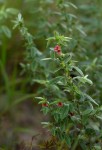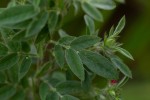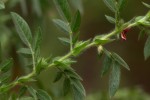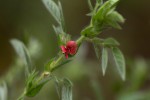Indigofera kuntzei
Selected images: Click on each image to see a larger version and details of the record View all images (5)
Detailed records: Display species records QDS maps by: Google Maps Point records by Google Maps
Species details: Click on each item to see an explanation of that item (Note: opens a new window)
| Synonyms: |
Indigofera faulknerae J.B. Gillett |
| Common names: | |
| Frequency: | Occasional |
| Status: | Native |
| Description: |
Erect to spreading annual or bushy perennial herb to 0.6 m tall, arising from a woody taproot. Stems many-branched, yellowish to red or purple, ± densely grey to white woolly, villous or sericeous with long, very unequally biramous hairs; densely scattered with reddish pearl bodies. Stipules 4–15 × 1–3.5(4) mm, 3–4 times as long as wide, mostly more than twice petiole length, obliquely lanceolate, acuminate, apex sometimes with a minute stalked gland (more frequently so in juvenile specimens), base rounded-cordate, oblique, sparsely to densely sericeous to villous. Leaves pinnately (3)5–7-foliolate, lateral leaflets sometimes smaller; leaf axis 4–26 mm long including (1)2–6 mm petiole, rachis extended 1–5 mm beyond lateral leaflets; stipels sometimes present; terminal leaflet 6–19 × 2–8 mm, elliptic-oblong to oblanceolate or lanceolate, up to 3 times as long as wide, apex acute to obtuse, base rounded, densely sericeous to villous with long hairs, coarsely strigose with ± equally biramous hairs above, ± densely villous to sericeous belowh with long hairs only; leaflets sometimes tipped with minute stalked glands. Inflorescence on younger shoots of short 1–2(3)-flowered racemes in axils of well developed or reduced bract-like leaves, or comprising condensed lateral shoots, ± paniculate with overlapping racemes obscuring much reduced leaves; racemes 2–4 mm long, subsessile or including a peduncle to 1–2 mm long; bracts 1.5–3 mm long, linear-lanceolate to subulate, caducous; pedicels 0.5–1 mm long, spreading to reflexed. Calyx 2.5–3.5 mm long, sericeous to villous, tube c.0.5 mm long, lobes 2–3 mm long, linear-attenuate, sometimes tipped with minute stalked glands in juvenile specimens. Corolla 4.5–5.5 mm long, red; standard dorsal surface hyaline-pubescent, distal margin of keel sparsely pilose to subglabrous, keel apex obtuse. Stamens 3.5–4 mm long, slightly exceeding calyx. Style 2–2.5 mm long, bending to erect in middle. Pods 3.5–6 × 1.5–2 mm, ovoid to oblong or subcylindrical, spreading to reflexed, silky-villous, apex acute, style-base persistent forming a beak; endocarp with 2 stripes of tannin deposits. Seeds 1–4, c.1.5 × 1.2 mm, squarish, pale coloured. |
| Type location: |
Mozambique |
| Notes: | This species belongs to a group of similar, related taxa, including I. eylesiana from Zimbabwe and I. inhambanensis. Both those species are distinguished by the strictly 3-foliolate leaves. |
| Derivation of specific name: | kuntzei: after Carl Ernst Otto Kuntze (1843-1907), German botanist, author and collector. |
| Habitat: | Woodland margins, secondary grassland and old cultivated lands, in deep white sand, often in overgrazed areas |
| Altitude range: (metres) | 0 - 300 m |
| Flowering time: | |
| Worldwide distribution: | Tanzania, Malawi and Mozambique. |
| FZ divisions: | Z,MS |
| Growth form(s): | |
| Endemic status: | |
| Red data list status: | |
| Insects associated with this species: | |
| Spot characters: | Display spot characters for this species |
| Images last updated: | Sunday 2 October 2022 |
| Literature: |
Schrire, B.D. (2012). Papilionoideae-Indigofereae Flora Zambesiaca 3(4) Pages 148 - 149. |
Other sources of information about Indigofera kuntzei:
Our websites:
Flora of Malawi: Indigofera kuntzeiExternal websites:
African Plants: A Photo Guide (Senckenberg): Indigofera kuntzeiAfrican Plant Database: Indigofera kuntzei
BHL (Biodiversity Heritage Library): Indigofera kuntzei
EOL (Encyclopedia of Life): Indigofera kuntzei
GBIF (Global Biodiversity Information Facility): Indigofera kuntzei
Google: Web - Images - Scholar
iNaturalist: Indigofera kuntzei
IPNI (International Plant Names Index): Indigofera kuntzei
JSTOR Plant Science: Indigofera kuntzei
Mansfeld World Database of Agricultural and Horticultural Crops: Indigofera kuntzei
Plants of the World Online: Indigofera kuntzei
Tropicos: Indigofera kuntzei
Wikipedia: Indigofera kuntzei




